-
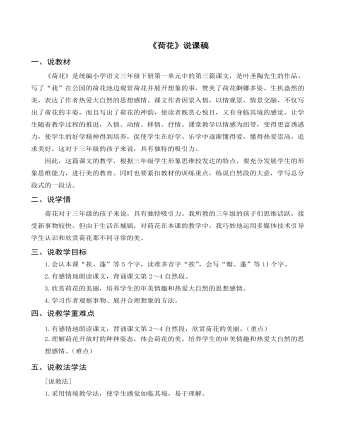
(说课稿)部编人教版三年级下册《荷花》
四、说教学重难点1.有感情地朗读课文,背诵课文第2~4自然段,欣赏荷花的美丽。(重点)2.理解荷花开放时的种种姿态,体会荷花的美。培养学生的审美情趣和热爱大自然的思想感情。(难点)五、说教法学法[说教法]1.采用情境教学法,使学生感觉如临其境,易于理解。2.直观教学法:通过多媒体的直观演示,激发学生学习课文的兴趣,突破教学难点。 3.以读代讲法。教学时让学生通过各种形式的读,读中理解,读中体会。[说学法]1.遵循以学生为主体,教师为主导,训练为主线的“三为主”原则,学生采用:看、听、读、品的方法学习。 2.采用探究性学习方法,使学生在阅读后自主探究合作。

(说课稿)部编人教版三年级下册《火烧云》
一、说教材《火烧云》是统编小学语文三年级下册第七单元的一篇精读课文,这是一篇非常优美的写景之作,著名女作家萧红以热情酣畅的笔墨给我们勾画了一幅绚丽多姿的火烧云图景。作者以多个不同构词形式的词语描述了火烧云的颜色变化,渲染了红霞飞舞、瞬息万变、目不暇接的奇妙景观;而后又描写了火烧云各种奇妙的形态,向我们勾勒出三幅动态的画面:跪着的马、凶猛的狗、威武的狮子,而且十分传神地写出瞬息之间由小到大、由清楚到模糊、最后不见的变幻过程。文中景物美和语言美有机地融为一体,让读者充分领略了火烧云这一自然景观的绚丽多彩。通过学习本文,激发学生热爱生活、热爱大自然的情趣,培养学生丰富的想象能力。

(说课稿)部编人教版三年级下册《 蜜蜂》
四、说教法学法1.谈话激趣法 在学生交流所搜集信息的基础上,我适时谈话激趣拨动学生理智的琴弦,由此,“披情入文”达到“未成曲调先有情”的效果,在课堂中,我会利用精炼的语言,或指导,或点拨,或解疑,或释惑,将学生的思维不断引向深入。 2.体验教学法让学生走进课文,体验文中人物的情绪变化,与文本展开零距离的对话,实现“三维一体”的教学。 3.读书指导法在课堂教学中,我将通过“初读、精读、赏读、活读”等方式指导学生朗读,让学生步步深入,在教材中走上几个来回,从而提高学生的语文综合素养。自主探究、合作的学习法。新课标倡导自主、合作、探究的学习方式。”因此,在了解怎样做试验的过程中,我放手让学生读、思、划、议,通过自主学习和相互间的合作交流,明白科学试验的严谨态度。
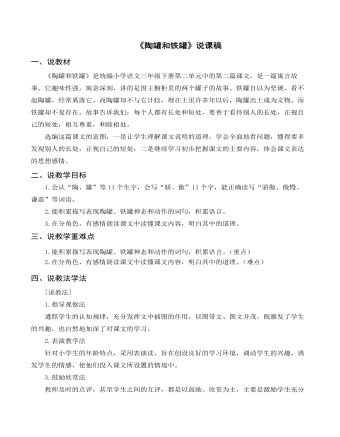
(说课稿)部编人教版三年级下册《 剃头大师》
三、说教学重难点1.能积累描写表现陶罐、铁罐神态和动作的词句,积累语言。(重点)2.在分角色、有感情朗读课文中读懂课文内容,明白其中的道理。(难点)四、说教法学法[说教法]1.指导观察法遵照学生的认知规律,充分发挥文中插图的作用,以图带文、图文并茂,既激发了学生的兴趣,也自然地加深了对课文的学习。 2.表演教学法 针对小学生的年龄特点,采用表演读,旨在创设良好的学习环境,调动学生的兴趣,诱发学生的情感,使他们投入课文所设置的情境中。 3.鼓励欣赏法 教师及时的点评,甚至学生之间的互评,都是以鼓励、欣赏为主,主要是激励学生充分地展示才能,满足他们希望得到赞许,体会成功的心理特点,激起学生学习的欲望,增强朗读的信心。

(说课稿)部编人教版三年级下册《 燕子》
一、说教材《燕子》是统编小学语文三年级下册第一单元中的第二篇课文。是一篇写景状物的文章,描绘了春天里燕子活泼机灵的外形体态,特别是春光中飞掠和憩息的优美画面。在文中,作者描绘了充满生机的如诗如画般的春天景色,赞美了伶俐可爱的小燕子,表达了对光彩夺目的春天到来的欢欣热爱之情。 文章的篇幅短小、条理性强、语句优美,作者的观察细致入微,表现了燕子的可爱,春天的美丽,既是对学生进行朗读背诵训练的好文章,也是本单元培养学生观察和表达的好材料,又是对学生进行审美教育的好素材。选编这篇课文的主要意图是通过阅读课文,让学生了解春天的特征,了解燕子的外形及活动情况,激发学生热爱大自然的思想感情;学习作者细致观察和具体生动地描写事物的方法,培养学生观察和想象的能力。
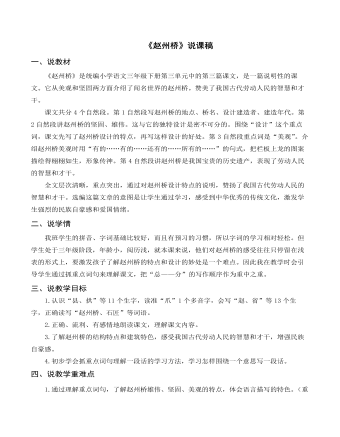
(说课稿)部编人教版三年级下册《 赵州桥》
一、说教材《赵州桥》是统编小学语文三年级下册第三单元中的第三篇课文,是一篇说明性的课文。它从美观和坚固两方面介绍了闻名世界的赵州桥。赞美了我国古代劳动人民的智慧和才干。 课文共分4个自然段。第1自然段写赵州桥的地点、桥名、设计建造者、建造年代。第2自然段讲赵州桥的坚固、雄伟。这与它的独特设计是密不可分的。围绕“设计”这个重点词,课文先写了赵州桥设计的特点,再写这样设计的好处。第3自然段重点词是“美观”。介绍赵州桥美观时用“有的……有的……还有的……所有的……”的句式,把栏板上龙的图案描绘得栩栩如生,形象传神。第4自然段讲赵州桥是我国宝贵的历史遗产,表现了劳动人民的智慧和才干。全文层次清晰,重点突出,通过对赵州桥设计特点的说明,赞扬了我国古代劳动人民的智慧和才干。选编这篇文章的意图是让学生通过学习,感受到中华优秀的传统文化,激发学生强烈的民族自豪感和爱国情绪。
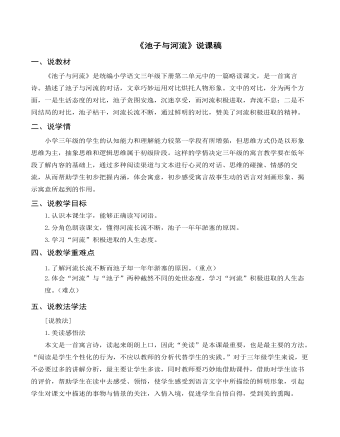
(说课稿)部编人教版三年级下册《池子与河流》
一、说教材《池子与河流》是统编小学语文三年级下册第二单元中的一篇略读课文,是一首寓言诗。描述了池子与河流的对话,文章巧妙运用对比烘托人物形象。文中的对比,分为两个方面,一是生活态度的对比,池子贪图安逸,沉迷享受,而河流积极进取,奔流不息;二是不同结局的对比,池子枯干,河流长流不断,通过鲜明的对比,赞美了河流积极进取的精神。二、说学情小学三年级的学生的认知能力和理解能力较第一学段有所增强,但思维方式仍是以形象思维为主,抽象思维和逻辑思维属于初级阶段。这样的学情决定三年级的寓言教学要在低年段了解内容的基础上,通过多种阅读渠道与文本进行心灵的对话、思维的碰撞、情感的交流,从而帮助学生初步把握内涵,体会寓意,初步感受寓言故事生动的语言对刻画形象、揭示寓意所起到的作用。三、说教学目标1.认识本课生字,能够正确读写词语。 2.分角色朗读课文,懂得河流长流不断,池子一年年淤塞的原因。3.学习“河流”积极进取的人生态度。
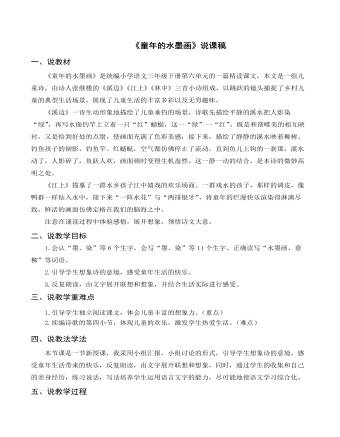
(说课稿)部编人教版三年级下册《童年的水墨画》
一、说教材《童年的水墨画》是统编小学语文三年级下册第六单元的一篇精读课文,本文是一组儿童诗,由诗人张继楼的《溪边》《江上》《林中》三首小诗组成,以跳跃的镜头捕捉了乡村儿童的典型生活场景,展现了儿童生活的丰富多彩以及无穷趣味。 《溪边》一诗生动形象地描绘了儿童垂钓的场景。诗歌先描绘平静的溪水把人影染“绿”,再写水面钓竿上立着一只“红”蜻蜓,这一“绿”一“红”,既是和谐唯美的相互映衬,又是恰到好处的点缀,使画面充满了色彩美感;接下来,描绘了静静的溪水映着柳树、钓鱼孩子的倒影、钓鱼竿、红蜻蜓,空气都仿佛停止了流动,直到鱼儿上钩的一刹那,溪水动了,人影碎了,鱼跃人欢,画面顿时变得生机盎然。这一静一动的结合,是本诗的微妙高明之处。 《江上》描摹了一群水乡孩子江中嬉戏的欢乐场面。一群戏水的孩子,那样的调皮,像鸭群一样钻入水中,接下来“一阵水花”与“两排银牙”,将童年的烂漫快乐渲染得淋漓尽致,鲜活的画面仿佛定格在我们的脑海之中。
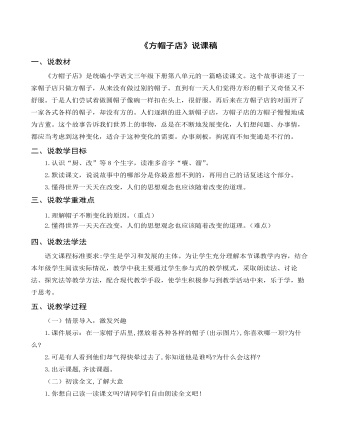
(说课稿)部编人教版三年级下册《方帽子店》
一、说教材《方帽子店》是统编小学语文三年级下册第八单元的一篇略读课文。这个故事讲述了一家帽子店只做方帽子,从来没有做过别的帽子。直到有一天人们觉得方形的帽子又奇怪又不舒服。于是人们尝试着做圆帽子像碗一样扣在头上,很舒服。再后来在方帽子店的对面开了一家各式各样的帽子,却没有方的。人们逐渐的进入新帽子店,方帽子店的方帽子慢慢地成为古董。这个故事告诉我们世界上的事物,总是在不断地发展变化,人们想问题、办事情,都应当考虑到这种变化,适合于这种变化的需要。办事刻板,拘泥而不知变通是不行的。二、说教学目标 1.认识“厨、改”等8个生字,读准多音字“嚷、溜”。 2.默读课文,说说故事中的哪部分是你最意想不到的,再用自己的话复述这个部分。 3.懂得世界一天天在改变,人们的思想观念也应该随着改变的道理。
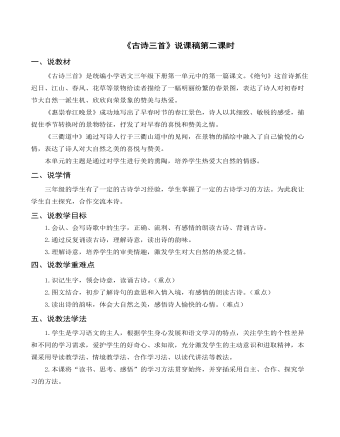
(说课稿)部编人教版三年级下册《古诗三首(二)》
一、说教材《古诗三首》是统编小学语文三年级下册第一单元中的第一篇课文。《绝句》这首诗抓住迟日、江山、春风、花草等景物给读者描绘了一幅明丽纷繁的春景图,表达了诗人对初春时节大自然一派生机、欣欣向荣景象的赞美与热爱。 《惠崇春江晚景》成功地写出了早春时节的春江景色,诗人以其细致、敏锐的感受,捕捉住季节转换时的景物特征,抒发了对早春的喜悦和赞美之情。 《三衢道中》通过写诗人行于三衢山道中的见闻,在景物的描绘中融入了自己愉悦的心情,表达了诗人对大自然之美的喜悦与赞美。本单元的主题是通过对学生进行美的熏陶,培养学生热爱大自然的情感。二、说学情 三年级的学生有了一定的古诗学习经验,学生掌握了一定的古诗学习的方法。为此我让学生自主探究,合作交流本诗。
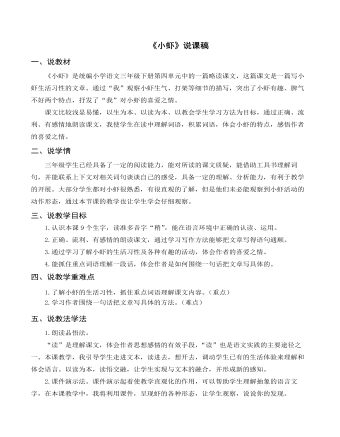
(说课稿)部编人教版三年级下册《小虾》
一、说教材《小虾》是统编小学语文三年级下册第四单元中的一篇略读课文,这篇课文是一篇写小虾生活习性的文章。通过“我”观察小虾生气、打架等细节的描写,突出了小虾有趣、脾气不好两个特点,抒发了“我”对小虾的喜爱之情。 课文比较浅显易懂,以生为本、以读为本、以教会学生学习方法为目标,通过正确、流利、有感情地朗读课文,我使学生在读中理解词语,积累词语,体会小虾的特点,感悟作者的喜爱之情。二、说学情三年级学生已经具备了一定的阅读能力,能对所读的课文质疑,能借助工具书理解词句,并能联系上下文对相关词句谈谈自己的感受,具备一定的理解、分析能力,有利于教学的开展。大部分学生都对小虾很熟悉,有很直观的了解,但是他们未必能观察到小虾活动的动作形态,通过本节课的教学也让学生学会仔细观察。

(说课稿)部编人教版三年级下册《枣核》
四、说教法学法[说教法]1.默读法 这篇课文篇幅长,故事围绕着主角展开,让学生通过默读的方式,熟悉课文的主要内容,了解这篇故事的大意,感受故事的趣味性。2.发现点拔教学法 《枣核》这篇课文具有传奇色彩,一个像枣核一样大小的孩子却有那么大本事,故事本身很吸引人。要引导学生在学习课文的过程了解课文的主要内容,同时对课文主旨予以点拨。[说学法]1.自主学习法 要求学生课前要做好预习,了解课文内容,对不认识的生字学会自己查字典,对不熟悉的词语自己标记出来,在课堂上提出来集体讨论。对课后习题在预习中要有自己的思考。 2.朗读法 这篇课文语言生动活泼,具有很强的趣味性和画面感。要让学生通过充分的朗读了解故事的主要内容,体会故事的主旨,并在弄通故事大意的基础上能用自己的话复述故事。

部编版三年级下册语文口语交际《劝告》说课稿
统编教材语文三年级下册第七单元口语交际 《劝说》说课稿 今日,我说课的题目是统编教材小学语文三年级下册第七单元口语交际《劝说》。我主要从以下六个方面进展说课,一、说教材,二、说学情,三、说教学目标,四、说教学过程,五、说板书设计,六、说教学反思。 一、说教材 “劝说”是日常人际交往中常用的沟通方式,也是现代公民现实生活的需要。本课教材由三局部组成。 第一局部是一幅情境图,一个同学坐在楼梯扶手上往下滑。通过泡泡图里三个同学的不同劝说,引发学生思索并争论:你觉得那个同学更有可能承受谁的劝说?为什么?在比拟中帮忙学生感知、理解劝说的要领。
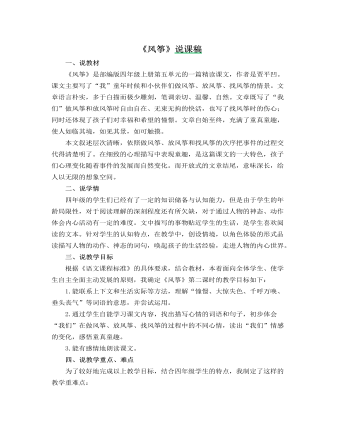
(新)部编人教版四年级上册《风筝》说课稿
六、说教学流程良好的教学设想必须通过教学实践来完成的,本课我预设两课时完成:第一课时:学习生字,初读课文,感知课文的主要内容,初步体会“我们”心情的变化。第二课时:感悟课文,体会“我们”“做风筝、放风筝、找风筝”时的心情变化,感悟童真童趣。我本次说课的内容是第二课时的教学。(一)复习导入1.听写词语:风筝 蝴蝶 拔几根 幸福 托着 垂头丧气 半圈树梢 歇一歇 千呼万唤 踪影 磨坊2. 这课文写出了作者童年做风筝放风筝时的快乐的情景。这节课让我们细细体会其中的快乐。(板书:风筝)(设计理念:由回忆放风筝的情景,引入课题,既锻炼了学生的表达能力,又勾起了他们美好的回忆,再次感受放风筝给他们带来的乐趣。让学生在已有生活经验基础上构建知识,使学生在不知不觉中感悟,培养学生在面对新知时,能主动寻找其现实背景的能力,激发了学生学习的积极性。)
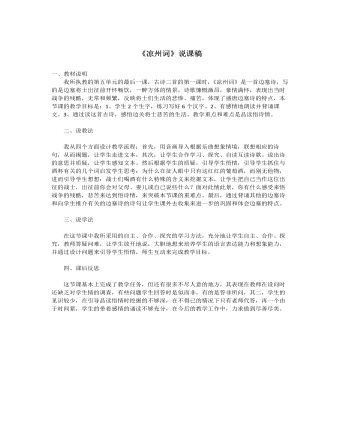
(新)部编人教版四年级上册《古诗三首》说课稿(二)
一、教材说明我所执教的第五单元的最后一课,古诗二首的第一课时,《凉州词》是一首边塞诗,写的是边塞将士出征前开怀畅饮,一醉方体的情景,诗歌慷慨激昂,豪情满怀,表现出当时战争的残酷,无常和频繁,反映将士们生活的悲惨、痛苦。体现了盛唐边塞诗的特点,本节课的教学目标是:1、学生2个生字,练习写好6个汉字。2、有感情地朗读并背诵课文。3、通过读这首古诗,感悟边关将士悲苦的生活。教学重点和难点是品读悟诗情。
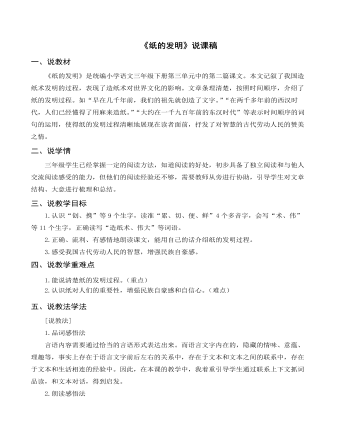
(说课稿)部编人教版三年级下册《纸的发明》
二、说学情三年级学生已经掌握一定的阅读方法,知道阅读的好处,初步具备了独立阅读和与他人交流阅读感受的能力,但他们的阅读经验还不够,需要教师从旁进行协助,引导学生对文章结构、大意进行梳理和总结。三、说教学目标1.认识“创、携”等9个生字,读准“累、切、便、鲜”4个多音字,会写“术、伟”等11个生字,正确读写“造纸术、伟大”等词语。 2.正确、流利、有感情地朗读课文,能用自己的话介绍纸的发明过程。3.感受我国古代劳动人民的智慧,增强民族自豪感。四、说教学重难点1.能说清楚纸的发明过程。(重点)2.认识纸对人们的重要性,增强民族自豪感和自信心。(难点)

部编人教版三年级下册《习作七 国宝大熊猫》说课稿
一、说教材本单元习作的话题是"国宝熊猫",引导学生根据问题查找信息并尝试学习整合有关信息。熊猫教材编排了三个部分内容,第一部分教材首先提供了关于大熊猫许多小朋友都想了解的三个问题,使得本次习作具有更强的针对性,教材呈现的三个问题,有的指向熊猫的,有的指向熊猫的生活的地方,而熊猫为什么被视为"中国的国宝",则指向熊猫的价值,他们只是问题罗列,是小朋友可能提出问题的一部分,其作用是让学生从这些问题受到启发,打开思路继续提出自己有兴趣的问题,第二部分首先明确了本次习作的任务就是围绕这个话题介绍一下熊猫,为介绍大熊猫奠定了基础。二、说教学目标1、针对教材提出的问题,搜集国宝大熊猫的相关资料信息。2、初步学习整合信息,从不同方面介绍国宝大熊猫。3、走进国宝大熊猫,学习整合信息,从不同方面了解大能猫。三、说教学重难点教学重点∶初步学习整合大熊猫的信息,结合资料,从自己感兴趣的方面介绍国宝大熊猫。教学难点∶利用搜集的信息,按一定的顺序准确地介绍大熊猫。
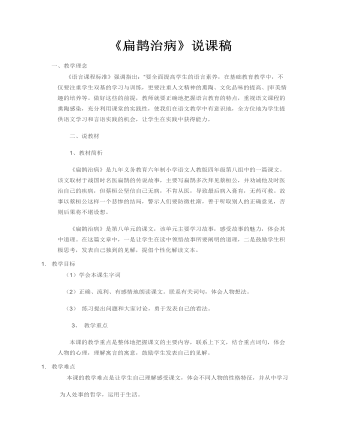
(新)部编人教版四年级上册《故事二则》说课稿(二)
一、教学理念《语言课程标准》强调指出:“要全面提高学生的语言素养,在基础教育教学中,不仅要注重学生双基的学习与训练,更要注重人文精神的熏陶、文化品味的提高、|审美情趣的培养等。做好这些的前提,教师就要正确地把握语言教育的特点,重视语文课程的熏陶感染,充分利用课堂的实践性,使我们在语文教学中有意识地,全方位地为学生提供语文学习和言语实践的机会,让学生在实践中获得能力。二、说教材1、教材简析《扁鹊治病》是九年义务教育六年制小学语文人教版四年级第八组中的一篇课文。该文取材于战国时名医扁鹊的传说故事,主要写扁鹊多次拜见蔡桓公,并劝诫他及时医治自己的疾病,但蔡桓公坚信自己无病,不肯从医,导致最后病入膏肓,无药可救。故事以蔡桓公这样一个悲惨的结局,警示人们要防微杜渐,善于听取别人的正确意见,否则后果将不堪设想。
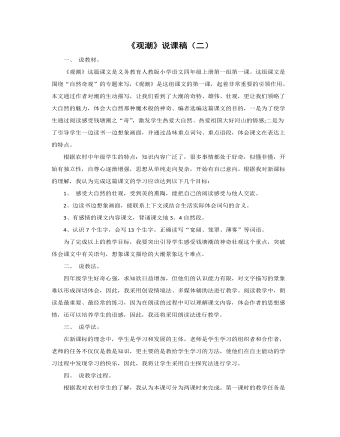
(新)部编人教版四年级上册 《观潮》说课稿(二)
一、 说教材。《观潮》这篇课文是义务教育人教版小学语文四年级上册第一组第一课。这组课文是围绕“自然奇观”的专题来写,《观潮》是这组课文的第一课,起着非常重要的引领作用。本文通过作者对潮的生动描写,让我们看到了大潮的奇特、雄伟、壮观,更让我们领略了大自然的魅力,体会大自然那种魔术般的神奇。编者选编这篇课文的目的,一是为了使学生通过阅读感受钱塘潮之“奇”,激发学生热爱大自然、热爱祖国大好河山的情感;二是为了引导学生一边读书一边想象画面,并通过品味重点词句、重点语段,体会课文在表达上的特点。根据农村中年级学生的特点:知识内容广泛了,很多事情都处于好奇,似懂非懂,开始有独立性,自尊心逐渐增强,思想从单纯走向复杂,开始有自己意向。根据我对新课标的理解,我认为完成这篇课文的学习应该达到以下几个目标:1、 感受大自然的壮观,受到美的熏陶,能把自己的阅读感受与他人交流。2、边读书边想象画面,能联系上下文或结合生活实际体会词句的含义。3、有感情的课文内容课文,背诵课文地3、4自然段。4、认识7个生字,会写13个生字。正确读写“宽阔、笼罩、薄雾”等词语。为了完成以上的教学目标,我要突出引导学生感受钱塘潮的神奇壮观这个重点,突破体会课文中有关语句,想象课文描绘的大潮景象这个难点。
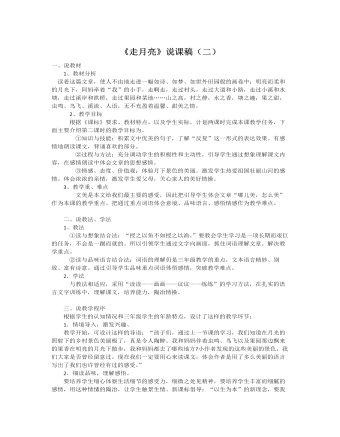
(新)部编人教版四年级上册 《走月亮》说课稿(二)
一、说教材1、教材分析读着这篇文章,使人不由地走进一幅如诗、如梦、如世外田园般的画卷中:明亮而柔和的月光下,阿妈牵着“我”的小手,走啊走,走过村头,走过大道和小路,走过小溪和水塘,走过溪岸和拱桥,走过果园和菜地……山之高,村之静,水之香,塘之趣,果之甜,虫鸣、鸟飞、溪流、人语,无不充盈着温馨、甜美之情。2、教学目标根据《课标》要求、教材特点、以及学生实际,计划两课时完成本课教学任务,下面主要介绍第二课时的教学目标为。①知识与技能:积累文中优美的句子,了解“反复”这一形式的表达效果。有感情地朗读课文,背诵喜欢的部分。②过程与方法:充分调动学生的积极性和主动性,引导学生通过想象理解课文内容,在感情朗读中体会文章的思想感情。③情感、态度、价值观:体验月下景色的美丽。激发学生热爱祖国壮丽山河的感情。体会浓浓的亲情,激发学生爱父母,关心家人的美好情操。

